German Spitz is a popular breed of decorative dogs. This lively, active pet is very attached to its owner. But despite its friendliness, the animal is not suitable for all people.
History of breed origin
German Spitz is a breed with a long history. This animal has become the progenitor of many other species of this dog. The ancestor of the Spitz is considered an extinct peat dog. His homeland is Germany, it was there that the animal got thanks to the Vikings in the 10th century BC. Despite the fact that after some time the representatives of this breed gained popularity in many parts of Europe, their name remained the same.
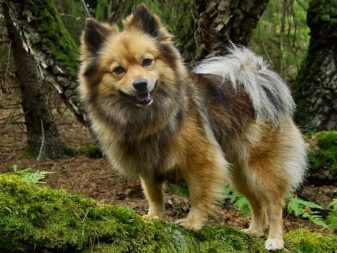
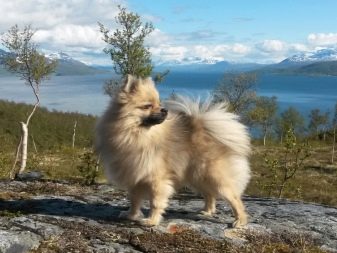
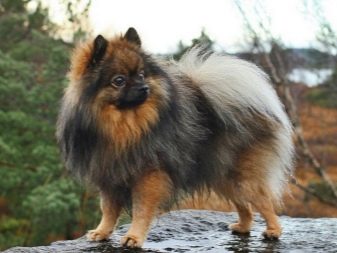

For the first time, an animal was mentioned in writing in the 15th century, describing it as an animal guarding peasant housing. Gradually, German Spitz began to appear in the society of aristocrats. Queen Charlotte is the first noble person who was the mistress of a dwarf dog. Since this woman was loved and respected in society, her pet began to enjoy no less popularity. In 1900 there was a meeting of connoisseurs of these dogs, after which they founded a Spitz club in which the first standard of this breed was adopted.
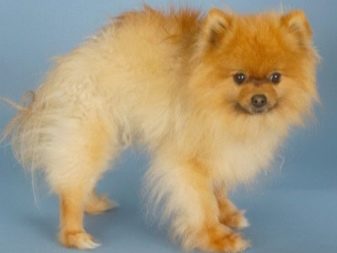
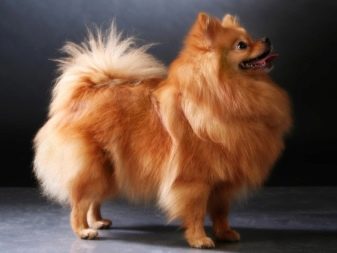
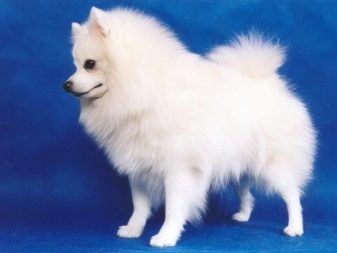
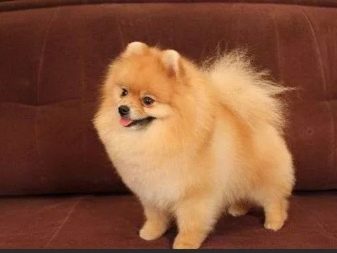
German Spitz was a favorite with Martin Luther, Marie Antoinette, Mozart, Empress Catherine, Ludwig Richter. Small dogs always performed well as a guard and informed their owners of the approaching guests. In addition, the Spitz coped well with the role of a shepherd, helping people to graze sheep and cows. Spitz with brown and black color was used to scare away birds in the vineyard.

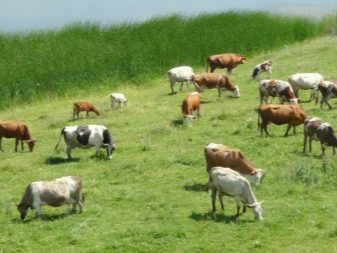
There is information that many centuries ago German Spitz were residents of the yards of the poor. This animal fiercely defended the compound and was not characterized by gluttony. Later, these advantages of dogs were appreciated by aristocrats and dogs began to be used to protect plantations, estates, and driving away predators. Two centuries ago, white spitzs became very popular among the rich layers of the population, and brown and orange individuals became a little less popular.
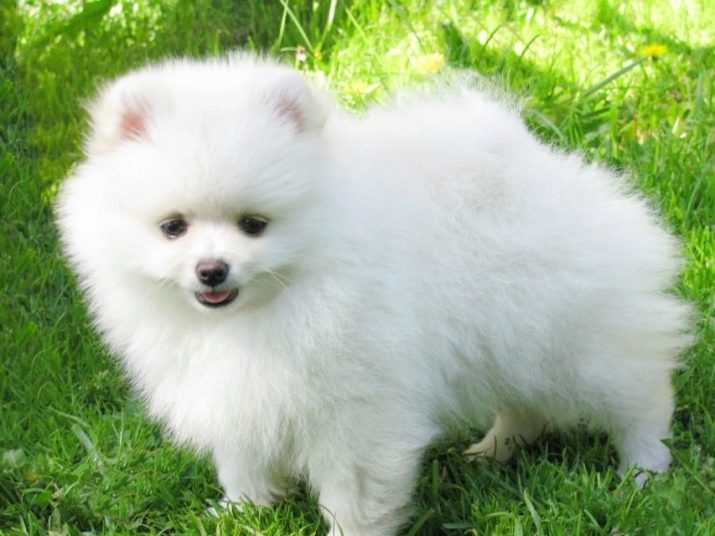
Having gained popularity among dog lovers, the animal moved from a class of working dogs to decorative. Already in the 19th century, German Spitz became the main exhibitor. This pet is a wonderful companion, a participant in circus performances. Currently, this breed of dog is recognized in FCI, so it is common in all parts of the planet.
Description
A cute and funny appearance, combined with a playful character, is what made a German Spitz a pet. This breed belongs to the ancients, it includes a large number of representatives of different subspecies, which are characterized by certain sizes, biological features.
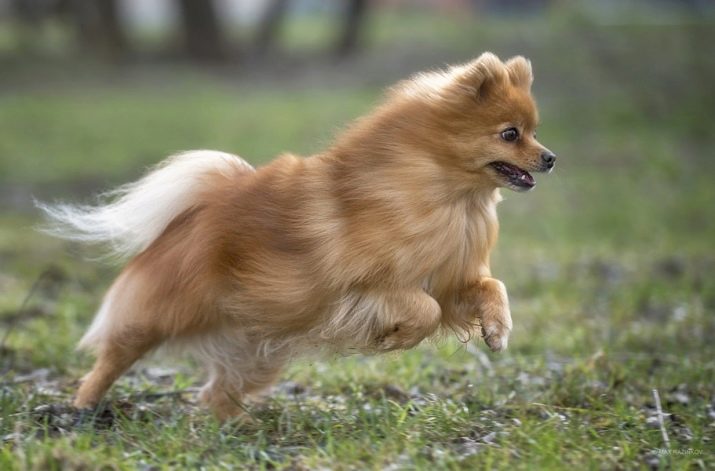
Body structure
Spitz dogs running on a leash look like fluffy balls. The exterior features of the dwarf, small, wolf spitz and middle spitz are almost the same, their difference is in height and weight. Each of the subspecies is characterized by a long straight coat, in which there is a thick undercoat. The ratio of the length of the body to its growth is 1 to 1. The muzzle of the dog is not characterized by excessive elongation; it can be bear or fox type.
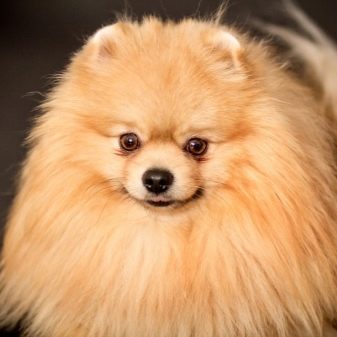
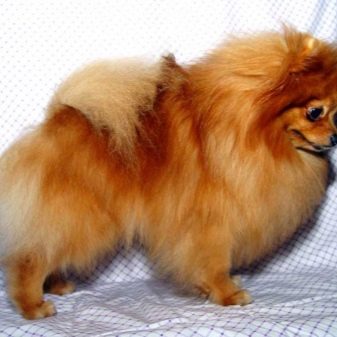
The muzzle near the nose is always colored black. The ears of the pet are small in size, they are triangular in shape and set straight. In representatives of this breed, the chest is strong and wide, the back is smooth, wide, but does not decrease towards the tail, like in other dogs.
The tail is fluffy, set high and twists in the form of a ring. The eyes of the animal have an elongated, sometimes rounded shape. The organs of vision are slanted, the iris is dark and the eyelids black and brown. The jaw of the pet is well developed, the neck is wide with a convex nape. This breed has a rather strong skeleton, muscular limbs and round paws with dense pads.

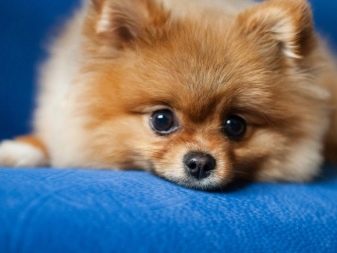
The physique of the Spitz is quite harmonious. According to the standard, the animal has the following characteristics.
- Weight an adult dog can range from 1,500 to 30,000 grams, often a female is smaller than a male.
- Height at the withers at the mini-spitz is 22 cm, but at the representative of a large species - up to 55 cm.
- Life span The animal is 12 to 15 years old. However, there are cases when pets survived to 20 years. This is influenced by the conditions of detention, nutrition, care.
- Color animal can be very different. According to the standard, the black Spitz must have a uniform color; on a spotted dog, the spots should be uniform on a white background.

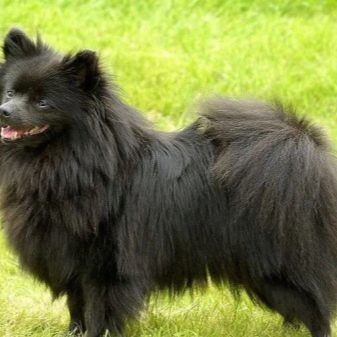
Character
German Spitz are lively and lively animals, they always take part in noisy fun, various games, active walks with their master. If a person is absent, then the pet behaves calmly, patiently, it does not destroy and does not destroy everything that is nearby only from boredom. Such a pet does not impose itself, it is waiting for the time when it will lead him for a walk. Mini-Spitz does not show credulity to strangers, so this dog is not only a sensitive watchman, but also a very noisy tenant.
The owner should remember that these animals should be instilled with good manners from an early age, while a person should be firm and persistent. Otherwise, the German Spitz will be uncontrollable, without any reason barking, moody and stupid creature that attacks passers-by and other animals.
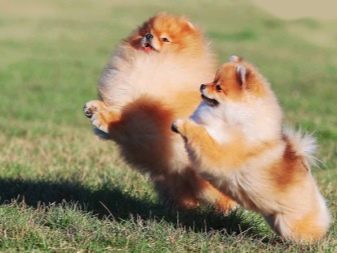
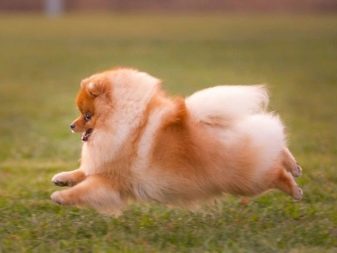
Each of the varieties of this breed is characterized by emotionality and jealousy. At the sight of an unfamiliar dog, a German Spitz is trying to start a quarrel.At the same time, this beast is inquisitive and faithful. This small and fervent creature was a favorite of emperors, while they were appreciated not only for their external qualities, but also for empathy, loyalty, and courage.
Spitz consider wonderful companion, since he is able to understand the feelings and experiences of the owner. The pet easily transfers trips and flights. If the animal feels, then the person is in danger, then he is able to boldly rush to his defense, despite the large dimensions of the enemy.
A small representative of the fauna can be not only a sofa dog, but also a nanny for a small child, he never snarls at his pranks. The animal is playful and energetic up to old age and it is very important for him to have contact with the owner. It is important for the pet that they pay attention, walk with it, stroke it, and be near it. Spitz is a smart, quick-witted and fairly balanced dog.

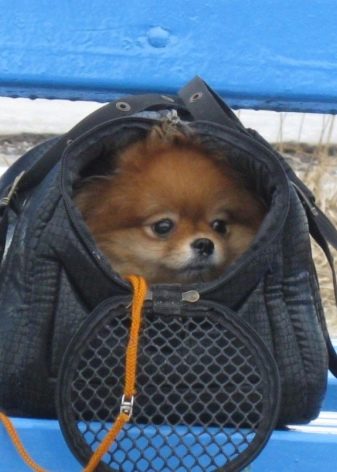
The dog attracts attention with the help of barking, jumping and running. The animal loves long walks, swimming, games. This sensitive creature remembers how it is treated, for this reason it is not worth physically punishing the dog or rudely raising it. When the animal grows old, it manifests anxiety, the pet hardly tolerates separation from the person, it begins to whine, bark and lock itself in.
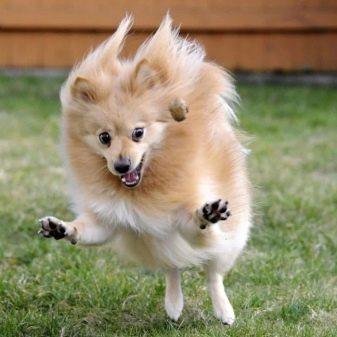
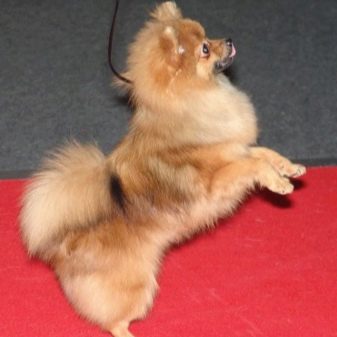
Colors
The generally accepted cynological standards state that the following types of color are characteristic of the German Spitz:
- Wolfspitz have a wolf color, as well as various shades of gray;
- large representatives of the breed are black, brown, white;
- medium and dwarf dogs are painted in black, white, chocolate, red, orange, cream.
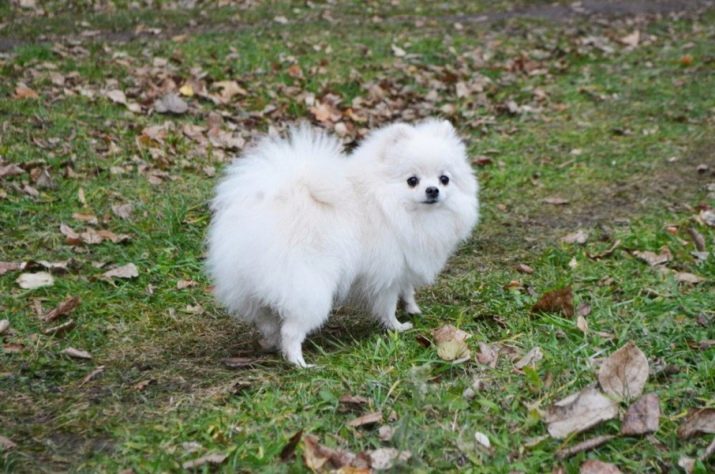
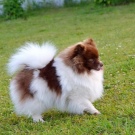
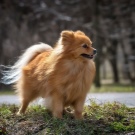
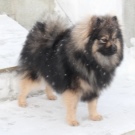
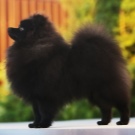
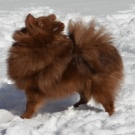
The coat of a black German pet should be characterized by uniformity, usually lacquer tint inherent in it without any spots and impregnations. Puppies can be brown or gray, however, after the process of molting, their hair will become saturated black. If the descendants of the animal had a different coat color, then perhaps the spitz, which was born black, after molting, the coat will change color. Such a phenomenon is not considered marriage.
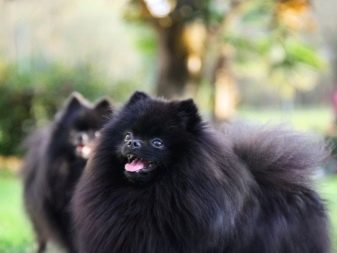
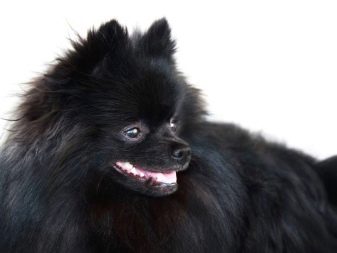
Brown representatives of this breed usually have fur that is evenly colored in a rich chocolate color. According to the standard, the lips, eyelids, and the tip of the dog’s nose can be brown, as the skin of the animal is deprived of the ability to produce melanin.
The standards indicate that white German Spitz should not have any impurities of other colors on the coat. A puppy of such an animal is also born snow-white. In the case of the presence of dogs with a different color among the descendants of the baby, it is possible that after molting, his fur will acquire a cream color. The most popular among dog lovers are red spitz, which is similar to miniature chanterelles.
Puppies of an orange pet can be light red or be characterized by the presence of an orange tint on a mostly gray background. To determine the color of the animal in adulthood, you can look at the fur behind the ears. This is exactly the color the dog will have after molting. According to the standard, a pet with red or orange fur should have a uniform color.
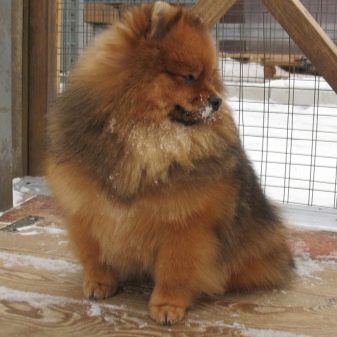
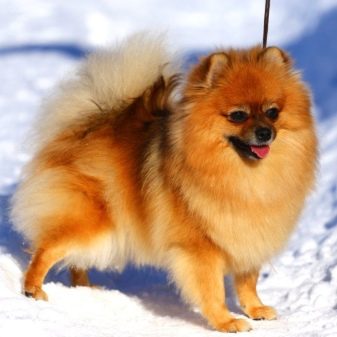
It is acceptable when there is a more saturated color on a certain area of the dog’s body. The gray, sable or wolf color of the German Spitz fur is characterized by a silver-gray shade of hair, the tips of which are colored black. The muzzle and ears of the pet are darker than the rest. A black outline is often present near the eyes.
The dog’s shoulders and lush mane have a light gray color, but the limbs are often silver. Dark touches may be present above the fingers, the tip of the tail is black, and the panties are gray. The perfect wolf color of the fur is characterized by German Wolfspitz. Other popular colors of the German Spitz are the following:
- cream color can be warm and cold;
- red sable fur in an adult pet in childhood is black with a red;
- black and tan;
- color with a white base.
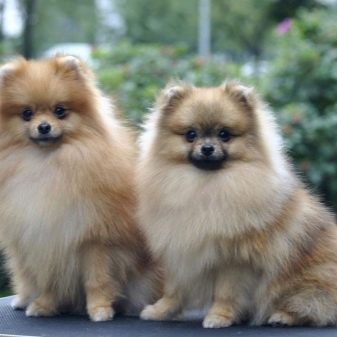
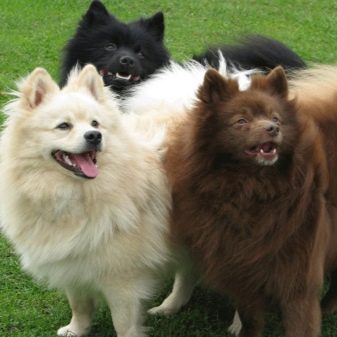
Life span
With proper care at home, German Spitz live for about 14 years. Despite the fact that this breed of dogs has a strong immunity, their existence can reduce some ailments. They do not have addictions to genetic diseases, but such health problems may arise.
- Subluxation of the knee and limb weakness. The reason for this condition of the animal is obesity, pregnancy, jumping. The owner should be wary if the dog is limping, a crunch is heard and pain occurs when the legs are bent. For prophylactic purposes, the Spitz should be given preparations that contain calcium, but only after consulting a veterinarian.
- Tooth diseases. Milk teeth of this pet are characterized by the presence of elongated roots, so when they are changed, problems often arise. In such situations, you should consult a doctor to remove teeth. In addition, stones can be formed on the German Spitz, which the veterinarian eliminates. To prevent and maintain the health of the animal’s teeth, it is worth brushing them regularly.
- Eye diseases. Such diseases are often observed in representatives with bulging eyes. Inflammation and secretions can result from wind, dust, or an excessively dry cornea.
- Digestive problems. Spitz can have dysbiosis and obesity. For the normal functioning of the digestive tract, the dog needs to be given fermented milk products.
- Coughing occurs in pets due to the structural features of the larynx. Constantly leaning over, the animal tries to cough out an allegedly foreign object from the throat. Spitz coughing is a common occurrence during games, the consumption of food and water, and also during overexcitation. You can help the animal by gently stroking his throat.
- Stunted growth. At a certain point in life, the pet stops growing, this happens due to the cessation of the production of a special hormone. Such an ailment can occur with an enlarged fontanel. Puppies with similar features slowly adapt and socialize. When stopping growth, you should turn to professionals.
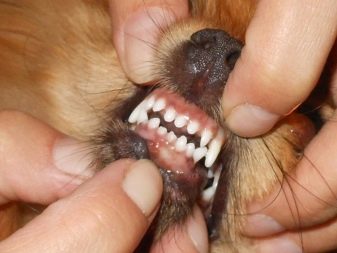
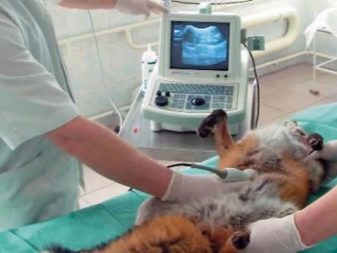
Animals need timely vaccination such an event will help to avoid or easier to transfer diseases of an infectious nature. Significantly reduce the immunity of the animal can worms, from which you need to be treated in a timely manner.
Experienced dog lovers recommend do not overfeed the German Spitz, since, despite an active lifestyle, this dog may be overweight. With a long absence of walks, the dog begins to feel bad, his immunity suffers, which entails health problems.


Regular physical activity and the correct diet of the animal is a guarantee that it will live a long and healthy life.
What to feed?
For beginner breeders, difficulties can arise in compiling a ration for a thoroughbred pet that eats in small portions. Dog handlers recommend keeping the spitz drinker clean and regularly filled with clean, fresh water. For a dwarf spitz that weighs 2500 grams, 0.15 liters of water per day is enoughif the conditions do not imply anything unusual. The daily volume of drinking fluid should be increased for puppies, lactating bitches and working pets.

Change the diet, the type of food is phased and tidy, this will take from 15 days to 2 months. This time will be enough for the animal’s body to adapt to a new type of food. German spitz nutrition should be regular and at the same time. Feeding the pet should be dosed. A dwarf dog that weighs 2500 grams needs to be given about 80 grams of food at a time, if the pet is overfed, then 50 grams will be enough.
If the German Spitz lives actively, then the norm can be increased to 120 grams. The diet should be balanced and complete, the main place in it should belong to protein. A dog weighing 2500 grams requires 50 grams of fish, cottage cheese, meat per day. The rest of the food is cereals and vegetables.
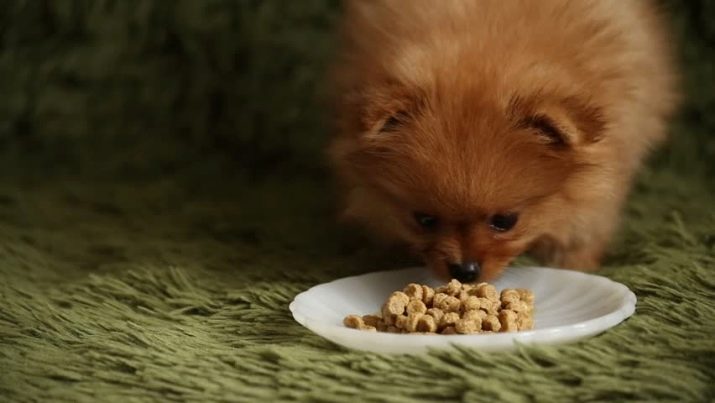
The components of the feed should correspond to the age, weight, activity of the dog. To feed puppies, you can use food with a soft texture that is rich in vitamins and protein.
In order for food to be biologically safe, it is necessary to carry out such measures:
- wash the dishes of the pet every time after eating;
- meat that was under the direct influence of sunlight, as well as incomplete food, should be discarded;
- wet food should be stored in the refrigerator;
- Do not give the animal products that look doubtful.

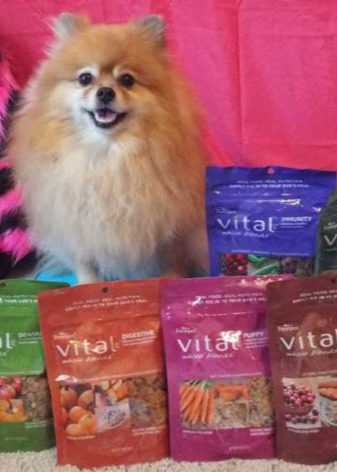
Puppies, like adult German spitz dogs, prefer protein products. If the owner decides to feed the dog homemade food, then the following products should be present in the diet:
- eggs, cheeses, meat, fish;
- cereals in the form of buckwheat, rice, oats, millet;
- vegetables in finely chopped form: carrots, beets, zucchini, cabbage, pumpkin, greens;
- salt, minerals, coal, limestone.

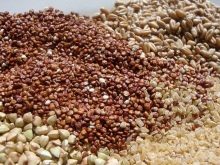

German Spitz puppies, which have just been taken from their mother or from the nursery, must be fed according to the instructions that the breeder offers. The kid should be accustomed to a balanced diet from an early age.
The first 6 weeks of the cubs need to be fed 6 times a day. The first feeding is carried out at 6-7 in the morning. The interval between meals should be 3, 5 hours. In the diet of puppies dairy products must be present in large quantities. When the baby turns 12 weeks old, it can be transferred to 5 meals a day, while the interval between meals should increase by 40 minutes. Gradually, the frequency of feeding should be reduced and reduced to two times a day. The nutritional schedule formed by the small dog should be maintained for subsequent years.

Dry food is considered convenient to use and hygienic, provided that they are selected correctly, thanks to them you can provide the German Spitz with the necessary substances and elements in the right amount. Premium feed, super premium and holistic class do not include components that can harm the animal.
The most popular feeds include the following.
- "Pro Plan Small & Mini Adult Optidigest." This product belongs to the premium class. The food is considered the most suitable for miniature dogs that have a sensitive digestive system. The basis of the product is lamb meat, as well as rice, prebiotics, corn, fiber.

- Eukanuba Adult Toy Breed. 32% of this product is poultry meat protein. The components of the feed include prebiotics, vitamins, fatty acid, and L-carnitine. This composition helps in regulating the weight of the dog.
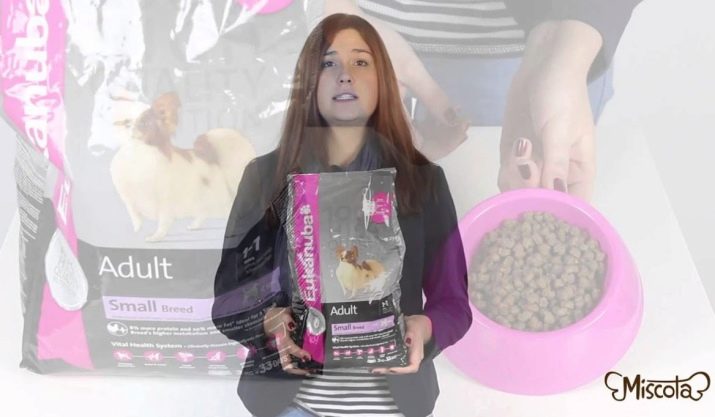
- "Acana Adult Small Breed" - holistic, which contains 60% of animal protein. Quick-type carbohydrates are presented in the form of algae, alfalfa, cranberries. This composition allows you to maintain optimal weight of the pet.
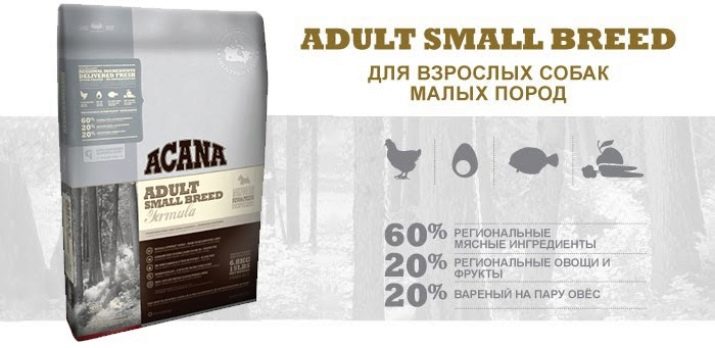
Sometimes a spitz requires a change of feed. It is necessary to conduct such an event with the following symptoms:
- the puppy has become an adult dog;
- during pregnancy or after sterilization;
- food allergy, which is expressed in diarrhea, combing, discharge from the ears, the presence of a rash on the skin;
- inferiority of food, which can be manifested in alopecia, dull hair, brittle claws;
- overweight;
- the need for a therapeutic diet.

Since German Spitzs are prone to obesity, their nutrition is worth watching. If the pet gains 300 grams more than the norm of its weight, then it may have cardiovascular diseases. Before serving a pet, it is worth preparing homemade food:
- meat products should be scalded or given raw;
- boil offal and fish;
- steamed vegetables or serve raw;
- give greens finely chopped;
- remove fish and meat from fish and meat.
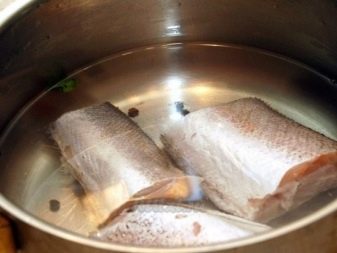

The main rule that should not be violated is that 2/3 of protein products and 1/3 of carbohydrates (vegetables, fruits) should be present in the diet of the Spitz.
An example of a German Spitz diet for 7 days.
Day of the week | Morning | Evening |
Monday | stew of vegetables, meat and greens | chicken breast, cottage cheese |
Tuesday | boiled meat, buckwheat | rice, boiled fish |
Wednesday | similar to the previous day | as on the previous day |
Thursday | raw turkey breast, raw vegetables | rice porridge, cottage cheese with sour cream |
Friday | monday menu | monday menu |
Saturday | lean meat, cottage cheese and fruits | buckwheat with beef, boiled egg and greens |
Sunday | porridge, crackers, greens, sea fish | boiled offal, rice porridge |
After the German Spitz is 7 years old, he should be transferred to feeding dry food for old dogs. Vitamins, polyunsaturated acids, glucosamine should be added to food. If an elderly animal has become inactive, then the owner should make the pet's portions smaller or reduce their calorie content. A pregnant female Spitz should be fed three times a day or more. The amount of food should be increased due to protein, not carbohydrates.
If a puppy is living on dry food, then he can be given an industrial product intended for puppies. Provided that the bitch is fed homemade food, she should add more vitamins, vegetables, sour-milk products to the diet. Vitamins are not added to dry food.
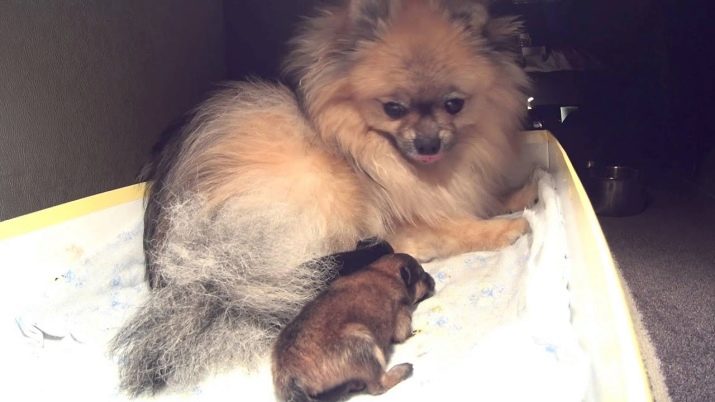
For example, if a female Spitz will receive an excessive amount of vitamin A, then the deformity of newborn puppies is possible. If the animal has developed a food allergy, then it should be transferred to a hypoallergenic dry food or removed from the diet food that can cause this condition.
How to care?
The German Spitz, like any other dwarf dog, needs care. Before a new resident appears in the apartment, it is worth securing the room. A dog should be treated like a small child. In this case, you need to perform the following activities:
- raise the wires, cables to a height from which the baby will not be able to get them;
- block the gaps behind the cabinets, sofas or expand them;
- secure the balcony;
- remove unstable and fragile objects, for example, vases, columns;
- eliminate slipping floors;
- collect all small items so that the animal does not swallow them;
- hide chemicals;
- move the bin so that the puppy does not turn it over during research;
- check the room for drafts that can cause puppy disease.

So that the content of a small German Spitz is correct and does not harm his health, you can heed such recommendations.
- You need to learn how to properly hold the puppy, for this it is worth asking the breeder for advice. In the baby in the first month of life, the muscular system is poorly developed, so it is taken with two hands, placed on one of them with the breast holding. Keeping your pet is tight, as it can break out and fall.
- Provide a puppy with a long sleep, which is very important for a growing organism. A well-slept dog will be playful and active.
- Do not leave the spitz on top, for example, on a sofa or high chair. A jumping animal can cause injuries and injuries.
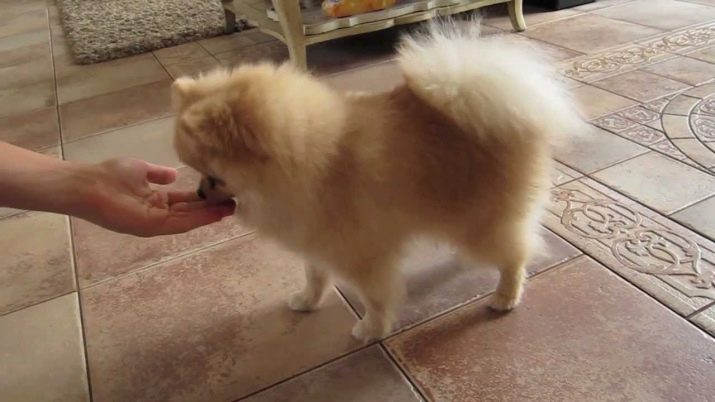
A puppy, which subsequently becomes an adult representative of the German breed, must have his own place where he will sleep and rest. It should not be placed in the dining room or living room, near balconies and radiators. Spitz sleeper should be located in the corner where he will be comfortable and calm, for example, in the master bedroom. You should not invite a pet to your bed, as he can get used to it, and weaning for such a dog will be quite painful.

For the puppy to sleep in comfort, he should buy a special basket or carrying with a mattress. The device with the sides will be safe for the baby. In order for the pet to get used to it faster, you can put treats or toys inside. Installation of an enclosure for a spitz will not be superfluous, provided that the owner is absent for a long time. It is worth placing a sunbed, a bowl of water, objects for entertainment.

As a toilet, the easiest a shop tray, which is covered with a waterproof diaper. When an animal appears in the house, you should immediately accustom it to the toilet. At first, the owner will have to plant the animal on his own until he gets used to it. Not only puppies of the Spitz need toys, but also adult dogs.
The acquisition of such accessories is a guarantee that a little friend will not spoil the furniture.
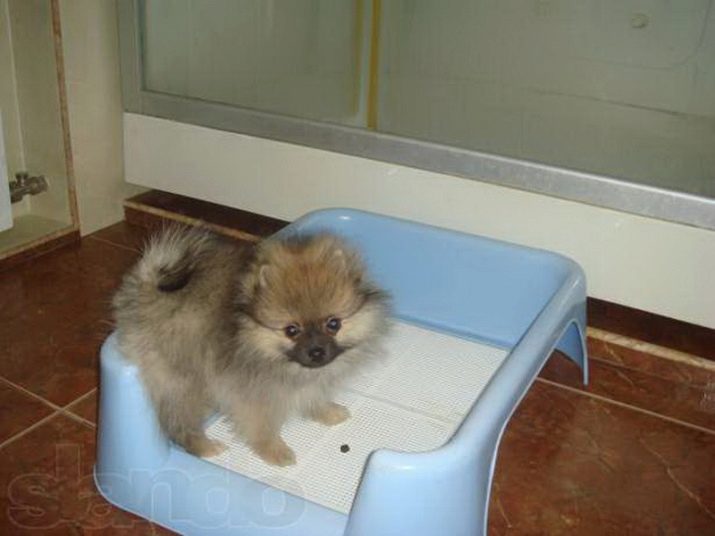
Pet toys need to be updated periodically, this will bring joy to the baby. Plastic entertainment items are quite dangerous; you should refuse to buy them, as well as rubber and metal elements. The best option would be special accessories for dogs or old baby teddy bears. German Spitz is a fun and active pet, so he needs to communicate with other dogs. It is strictly forbidden to cancel a walk with a pet if the weather is bad on the street.
The exception to staying at home is extreme heat or thunder. Walking the animal should be carried out only after all vaccinations.
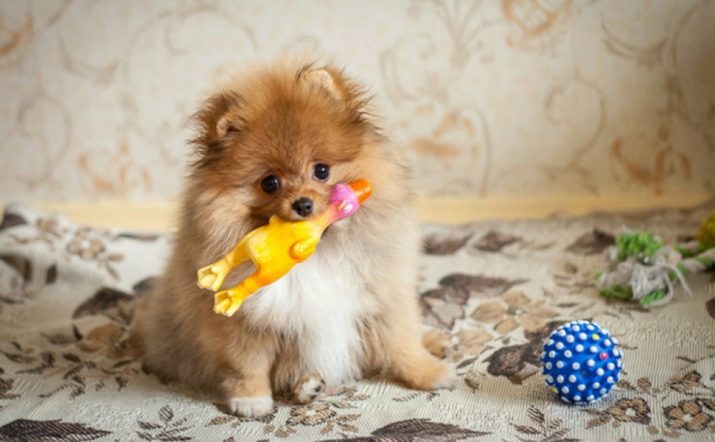
The first walks should last about 15 minutes. Spitz need to walk twice a day. If the baby does not have enough physical activity, then he will begin to play naughty indoors. With regular walks, the Spitz will relieve themselves during the walk. Such procedures have a beneficial effect on the pet’s metabolism, blood circulation, attention and learning ability.
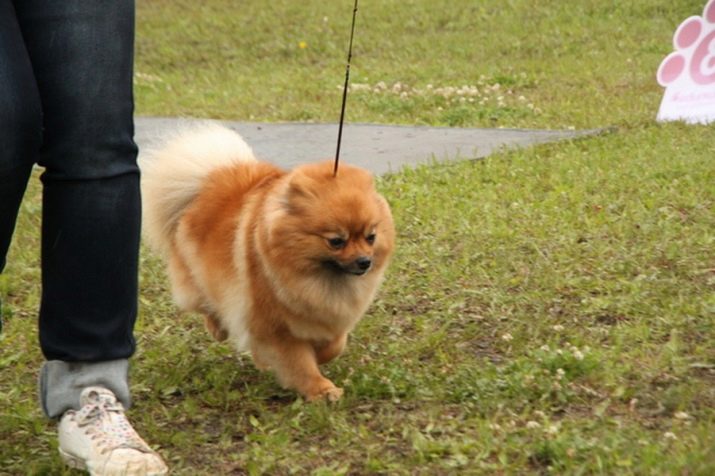
The breed of German Spitz is characterized by an attractive and spectacular coat. Its length and splendor require special care. The main molt in a pet happens during growing up, as well as in a female after birth. Throughout the rest of the time, molting in an animal is carried out sparingly. A representative of this breed needs combing twice for 7 days.
For combing spitz fur, the following accessories are needed:
- large soft slicker, which has a rubber base;
- two combs, one of which with rare teeth, and the second thick with metal;
- scissors with blunt endings.
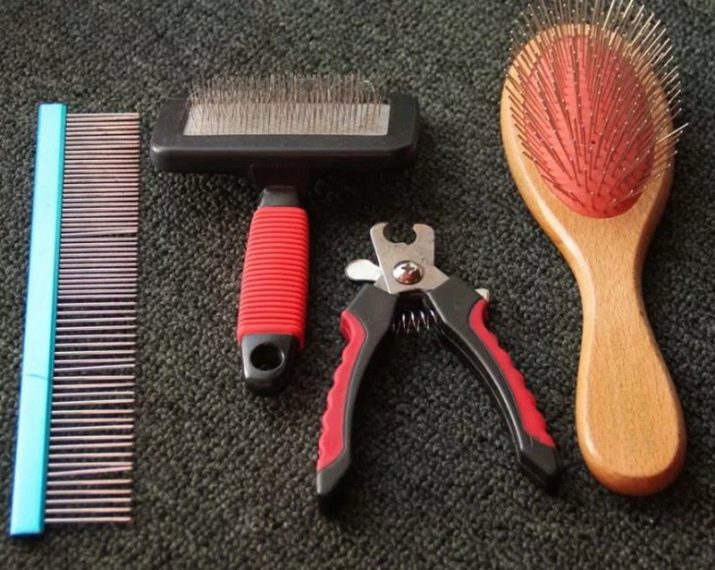
To avoid the formation of tangles, comb the baby is worth constantly with a slicker. The procedure is also necessary before bathing, while combing should be carried out from the root of the hair. It is not recommended to comb out dry fur, it is better to spray it with water in advance. It is necessary to bathe a thoroughbred pet as necessary and with pollution. Doing this is worth no more than once a month. At the end of walking, you just need to wash your baby's feet or wipe them.
When molting dogs do not bathe. During water procedures, it is worth using high-quality shampoos designed for dogs with long hair.
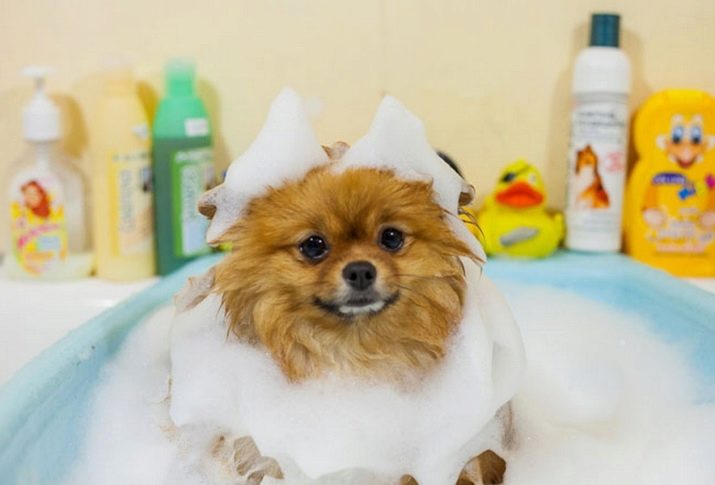
After bathing, you can rinse the dog’s fur with air conditioning to make combing easy. In the process of taking a bath, it is worth closing the ears of the doggie with cotton swabs. After swimming, take them out and wipe your hearing. Drying of wool can be done with a hairdryer while combing.
Due to the peculiarities of the German Spitz coat, the owner can cut it as he wants. A shorn pet can look like a lion, fox, teddy bear, bows and butterflies can be attached to the fur. According to generally accepted standards, wool should be shortened to a minimum.

Animal hair is cut so that the correct shape of the coat is obtained. The procedure starts from the head and ends on the tail. In the process, it is worth constantly combing the baby in order to avoid the appearance of protruding hairs.
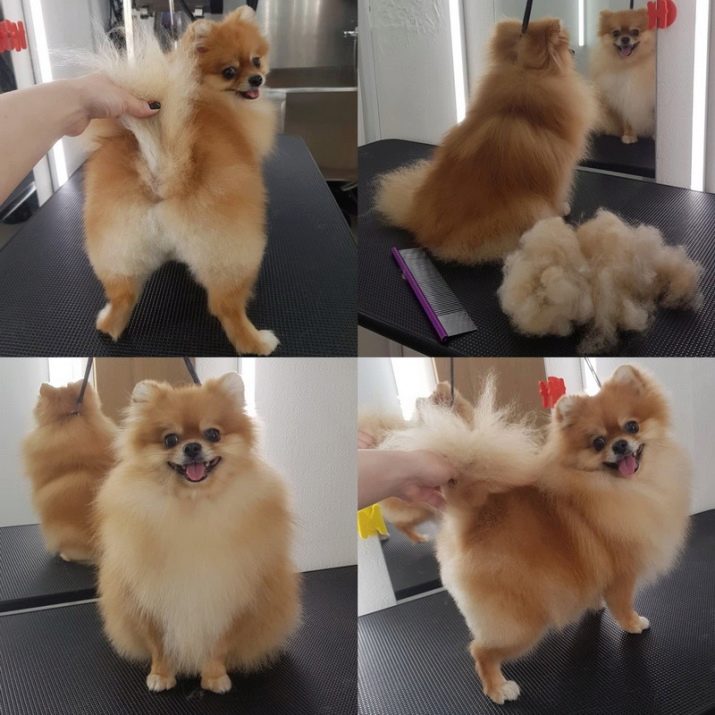
Also, the owner of this breed of dogs should not forget about caring for his ears. Due to the fact that the hearing organs of the Spitz are straight, their purification is not difficult. Ear diseases in a pet rarely occur, so their cleaning can occur without the use of medications. The auricles of an animal should always be clean and well-groomed.
Longhair dogs, which are characterized by bulging eyeballs, have problems with lacrimation. The cause of this situation may be the ingress of dust and dirt into them. It is worth caring for the eyes of the Spitz every day, for this they are wiped with dry napkins or cotton wool disks. If purulent secretions are found, you should immediately visit a veterinarian.
Clipping a pet's claws should be done every 2 weeks. In winter, the procedure can be carried out more often, since in the summer, the claws are grinded with asphalt. To painlessly cut the claws of a spitz, the owner should prepare a clipper, hydrogen peroxide, cotton buds and treats.
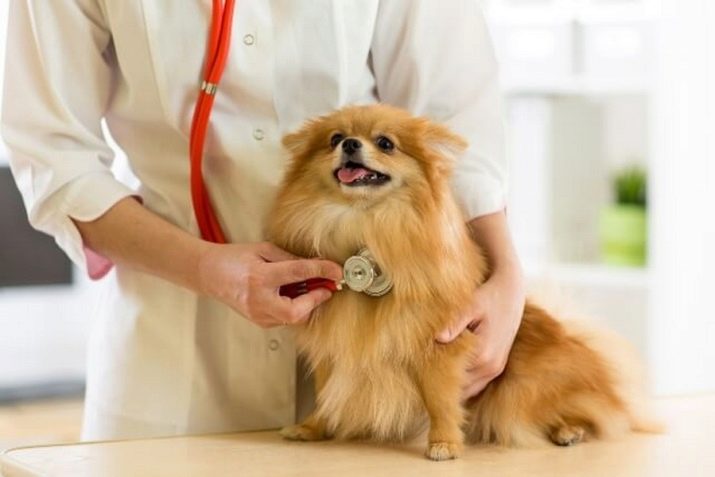
Pet teeth are cleaned twice for 7 days with a toothbrush and dog toothpaste. Alternatively, you can wrap a bandage on your finger and they walk through the oral cavity.
Parenting and training
German Spitz are endowed with intelligence and quick wit, so their potential should be directed correctly so that the pet does not become problematic and naughty. As soon as he first crosses the threshold of your home, he should begin to educate and train, while establishing strict subordination.
The animal must know where its place is, and go to him after the order. Spitz is trained in a playful way, practicing each of the teams until the desired result is achieved. He does not create problems in training, as he loves to please his master. Shouting at a dog, let alone beating it, is strictly forbidden. In the process, they give the dog encouragement, favorite toys and say kind words. The German Spitz is an excellent companion who looks pretty nice, but at the same time has the self-confidence and leadership habits, so you should not forget about his upbringing.
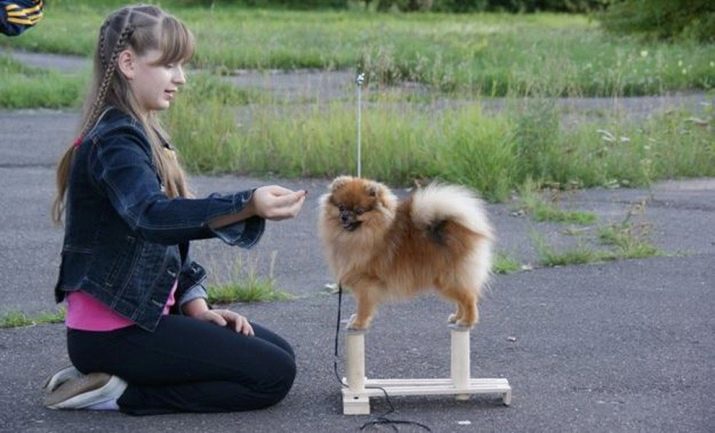
See how to properly train a German Spitz in the next video.








































